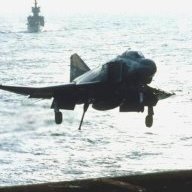Last week 'Reach for the Sky' was aired on the TV, starring Kenneth Moore in the role of Douglas Bader. It got me thinking of the other allied double-amputee fighter pilots.
I previously knew about the Russian/Ukranian pilots, but not the other British pilot, Colin "Hoppy" Hodgkinson. He has an autobiography called 'Best Foot Forward', which could be worth reading.
There's a story, whether true or not, maybe it's in his book, anyway he was supposed to have an aversion to ditching in the Channel with his tin legs (understandable). So what he did was fill his legs up with ping pong balls for flotation, not a bad idea when you think about it. At one stage, he climbed to 30,000 feet and performed a severe evasive maneuver after hearing what he thought was the sound of gunfire, but it turned out to be just the ping pong balls exploding in his legs due to the pressure differentation.
I gather there were quite a few pilots flying with one leg. These are the WW2 double amputee pilots that
I know of; possibly there's more:
Douglas Bader needs no introduction. Lost his right leg above the knee, left below the knee.
Pictured with his Hurricane.
[ATTACH=full]1818[/ATTACH]
Colin Hodgkinson, lost both legs learning to fly, then transferred from the Navy to the RAF to become a Spitfire pilot. Like Bader, he lost the right leg above the knee, the left below the knee and ended up being a POW after crash landing due to an oxygen failure. Went on to fly Vampires later in his career.
[ATTACH=full]1819[/ATTACH]
Colonel Alexei Maresev of the Soviet Air Force, HSU, a Russian, and the best known of the Soviet amputee pilots. Like Douglas Bader, he was the subject of a book and a movie.
He was shot down in a Polikarpov I-16 behind enemy lines in 1942. The crash broke the bones in both of his feet. He eluded capture for 18 days by first hobbling and then crawling on his hands and knees. By the time he made it back to the Soviet lines gangrene had set in and doctors had to amputate both legs below the knee. 11 victories, including 7 after losing his legs.
Pictured in front of a Lavochkin La-7
[ATTACH=full]1820[/ATTACH]
Captain Zakhar Sorokin, HSU, a Ukranian, of the Soviet Navy.
A fighter pilot with the Soviet Northern Fleet Air Arm. After scoring his fifth and sixth kills in a Mig-3, he had to crash land his plane in the Tundra. It took him 6 days to get to the nearest village, but his feet were severely frostbitten and had to be amputated at the ankle. Wearing the prosthetics he returned to combat flying and shot down 5 more German planes before the end of the war. I think he ended up flying P-39 Airacobras.
Pictured in front of what looks like a MiG-3.
[ATTACH=full]1822[/ATTACH]
Another Ukranian Naval Pilot was Major Leonid Belousov, HSU, of the Soviet Naval Air Arm.
He sustained injuries in a pre-war crash and lost both legs due to complications, four years later, in 1942. Like Bader and Hodgkinson, he lost the right leg above the knee & the left below the knee. He flew 300 sorties and scored 3 victories.
[ATTACH=full]1823[/ATTACH]
It would be hard enough flying with one leg.
Cheers, Willie.
[ATTACH]18422[/ATTACH]
[ATTACH]18431[/ATTACH]


